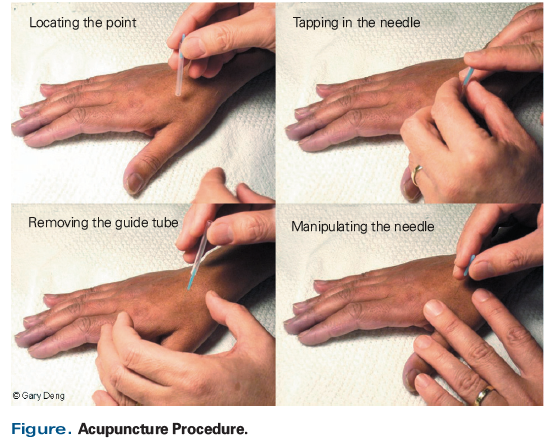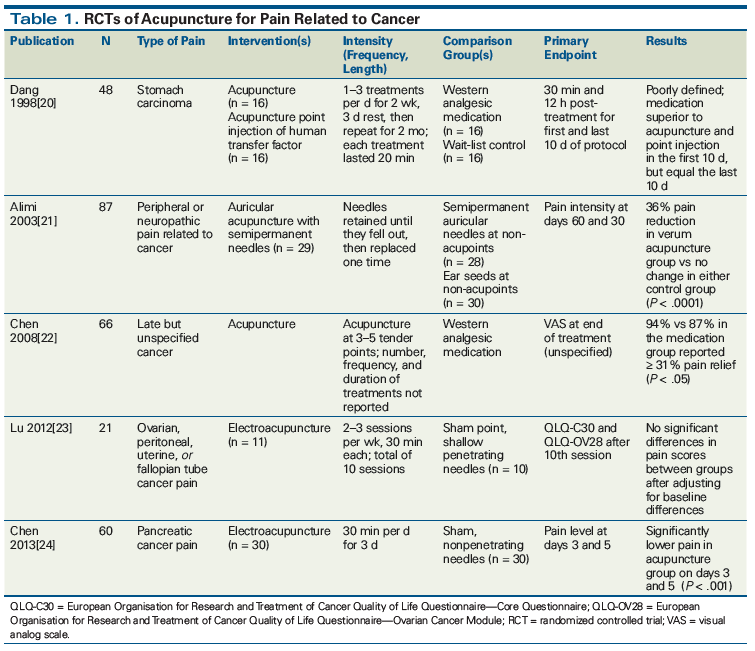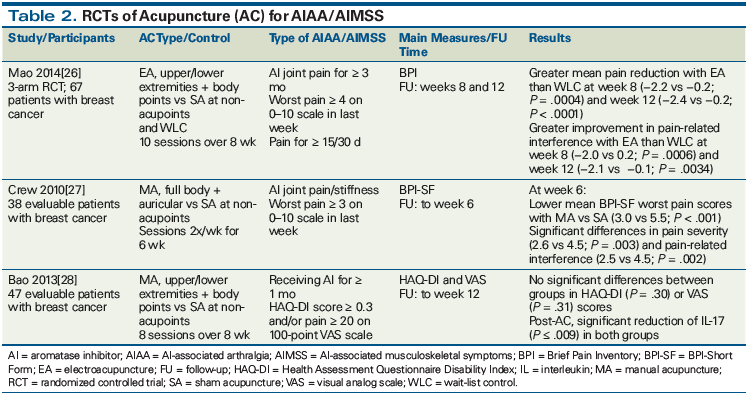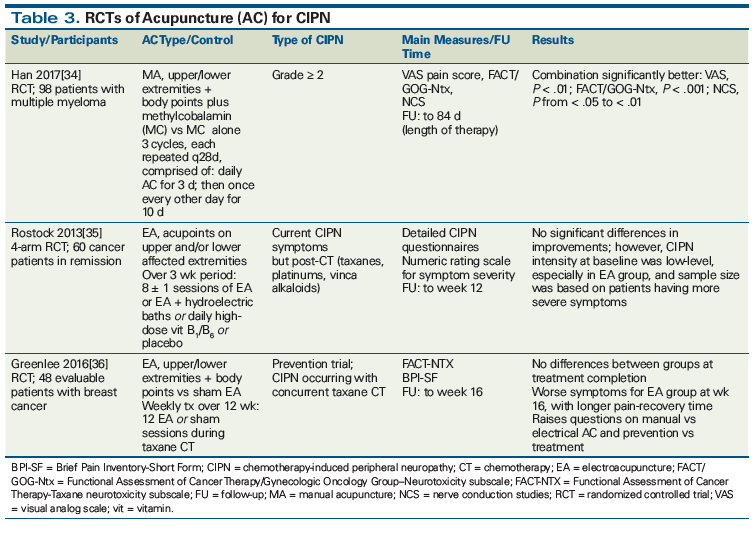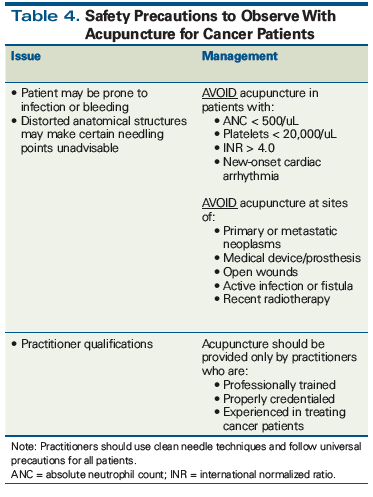This article summarizes the current evidence regarding the use of acupuncture for pain management in cancer patients. It includes a description of how acupuncture is thought to work and what the intervention entails, data on acupuncture for managing pain caused by cancer or by cancer treatment (radiation, chemotherapy, endocrine therapy), how acupuncture is practiced in the US medical system, discussion of safety issues, and practical tips on how to integrate acupuncture into cancer care.
Introduction
Pain is one of the most common, burdensome, and feared symptoms experienced by cancer patients.[1] Common sources of cancer pain can include the cancer itself, such as in bone metastasis, soft-tissue infiltration, or nerve compression, as well as the various modalities of cancer treatment, such as in chemotherapy-induced mucositis,[2] chemotherapy-induced musculoskeletal pain,[3] radiation dermatitis,[4] or radiation enteritis.[5] For many survivors, pain may become a long-term sequela of cancer treatment. In particular, taxanes, platinum compounds, vincristine, and bortezomib can cause chemotherapy-induced peripheral neuropathy that can manifest as long-lasting pain in some patients[6]; and aromatase inhibitors can cause persistent diffuse joint pain.[7]
Pain management for cancer patients encompasses both pharmacologic and nonpharmacologic interventions.[8] For pharmacologic options, mainstays for managing somatic pain include acetaminophen, nonsteroidal anti-inflammatory drugs, and opioids. Anticonvulsants such as gabapentin and pregabalin are used for neuropathic pain. Antidepressants, anxiolytics, and corticosteroids are sometimes used as adjuncts to enhance pain control. Aversion to treatment side effects and fear of developing addiction or tolerance are cited as reasons that patients may be reluctant to take adequate pain medicine.[9,10]
Nonpharmacologic interventions are an important part of a comprehensive pain management plan. Since January 2018, the Joint Commission, which accredits more than 20,000 US healthcare facilities, has required hospitals to pay more attention to safe opioid use and to include nonpharmacologic pain treatment modalities in its standard for pain management.[11] In addition, a recent National Cancer Institute (NCI) symposium on acupuncture highlighted the clinical evidence for its use in oncology symptom management.[12] Acupuncture is one of the nonpharmacologic interventions associated with fewer side effects and should be part of a multimodal approach to the management of pain.[13-15]
Acupuncture as a Medical Intervention
Acupuncture originated as a therapeutic modality in traditional Chinese medicine.[16] Its theoretical foundation can be traced back to Neijing (“The Yellow Emperor’s Classic of Internal Medicine”), compiled between 305 and 204 BCE. A relatively complete description of meridians and acupuncture points (or acupoints) on the body can be found in Zhenjiu jiayi jing (“Numbered book on acupuncture and moxibustion”), the oldest surviving writing on acupuncture and moxibustion (the application of heat to certain points on the body) published around 260 CE. Classical acupuncture involves the insertion of needles at selected acupoints to a defined depth, followed by manipulation with physical forces, heat, or more recently, electrical stimuli.
According to traditional Chinese medicine, vital energy (“chi” or “qi” in Chinese) flows throughout the body along meridian pathways. Interruption or obstruction of qi was believed to make one vulnerable to illness. The insertion of needles at specific meridian acupoints was thought to regulate the flow of qi, thus producing therapeutic benefit.
Although the ideas of qi and meridians are inconsistent with the modern understanding of human anatomy and physiology, recent neuroscience research suggests that acupuncture may provide clinical effects by modulating the nervous system. Neurotransmitters identified in laboratory research and neuronal matrices activated or deactivated during acupuncture have been observed in functional neuroimaging (functional MRI or positron emission tomography) studies.[17] Therefore, qi and meridians can be seen as vehicles used by ancient people to explain clinical responses observed during acupuncture.[18]
In a typical acupuncture treatment, the therapist interviews the patient; performs a physical examination, including pulse and tongue appearance (regarded as windows into the patient’s hemodynamic and microcirculation status); and then arrives at a traditional Chinese medicine diagnosis, which describes syndrome patterns rather than pathologic processes. For example, a constellation of insomnia, irritability, racing thoughts, dry mouth, and hot flashes represents the “heart fire” pattern. Acupoints are then selected based on the pattern diagnosis.
Single-use, sterile stainless steel needles protected by a guide tube are used in modern acupuncture practice. Acupuncture needles are filiform and very thin (28–40 gauge), similar to or thinner than insulin needles. In the United States, acupuncture needles are classified as medical devices. In a typical treatment, acupoints are located and the sites cleaned with alcohol swabs. The needle and its guide tube are placed at each site. A gentle tap applied to the top of the needle makes it penetrate the skin. The guide tube is then removed, and the needle advanced to the desired depth in a gentle twisting and pushing movement (Figure). The therapist may decide to apply heat or electrical stimuli to the needle. Traditionally, heat stimulation is provided by attaching a burning mound of the herb Artemisia vulgaris to the needle. In modern practice, it is provided by a heat lamp. In electroacupuncture, a small electric pulse–generating device connects to pairs of acupuncture needles to deliver electrical stimulation to the acupoints, in a manner akin to transcutaneous electrical nerve stimulation (TENS).
Management of Pain Caused by Cancer
Only a few randomized controlled trials (RCTs; five altogether [total N = 285]) have been conducted to specifically evaluate acupuncture for cancer-related pain (Table 1).[19] RCTs analyzed in a Cochrane review had either crossover or parallel group designs and excluded treatment-related pain such as chemotherapy-induced neuropathic pain or postoperative pain. Interventions included any type of invasive acupuncture: manual, auricular, or electroacupuncture. Comparison groups included no treatment, conventional treatment, sham nonpenetrative acupuncture, or penetrative acupuncture at non-acupuncture points. Primary outcomes were pain scores on scales such as visual analog scales (VAS) or numerical rating scales (NRS), or verbal reporting. Secondary outcomes included quality of life, patient satisfaction, decrease in analgesic consumption, length of hospital and hospice stay, and any adverse events (AEs).
In 1998, Dang and Yang compared 48 gastric cancer patients in two acupuncture groups with a Western medication group that received conventional medication based on the World Health Organization (WHO) analgesic ladder, and with a no-intervention control group. Patients in the Western medication group experienced more effective immediate analgesia during the first 10 days than did patients in the filiform needle or point injection groups, but by the final 10 days of the 2-month treatment period, the effects were similar. There were no significant differences between groups in either transient or long-term effects.[20] In 2003, Alimi and colleagues focused on auricular acupuncture for cancer-related neuropathic pain in 90 patients randomly divided among three groups: one group received two courses of auricular acupuncture at points where an electrodermal signal had been detected; and two placebo groups received auricular acupuncture either at points with no electrodermal signal (placebo points) or with auricular seeds fixed at placebo points. A decrease in VAS scores at 1 and 2 months with auricular acupuncture was found.[21] In 2008, Chen compared acupuncture with oral medication based on the WHO analgesic scale in 66 patients with late-stage unspecified cancer pain.[22] The percentage of participants showing ≥ 31% improvement in VAS scores was significantly higher with acupuncture (94.1% vs 87.5%; P < .05).
The Lu 2012 study randomized 21 women with ovarian cancer, peritoneal cancer, or uterine cancer to receive electroacupuncture or sham electroacupuncture. Although there were no significant differences in reported pain levels after baseline adjustments, improvements in the quality of life measure of social functioning were observed with electroacupuncture.[23] Finally, in 2013, Chen compared electroacupuncture vs sham placebo needles with no electric stimulation in 60 pancreatic cancer patients.[24] After three treatments, pain intensity measured using an NRS had been significantly reduced by electroacupuncture but not by sham acupuncture. Differences between the two groups were significant at treatment day 3 and again 2 days post-treatment.
The Cochrane analysis reveals a paucity of high-quality studies on acupuncture for cancer pain. No RCTs of acupuncture for pain directly related to cancer have been published since. The small samples sizes, inadequate blinding descriptions, heterogeneous cancer diagnoses, and different study methodologies do not allow for a definitive conclusion. At this juncture, it is fair to say that preliminary evidence suggests acupuncture may be effective for certain kinds of cancer pain in some patients. A short course of acupuncture can be considered for patients with intractable pain that is not adequately controlled otherwise. However, the evidence is not strong enough for us to recommend acupuncture as part of standard care for the management of pain directly related to cancer in adult patients.[19]
Management of Pain Caused by Cancer Treatment
Two types of pain caused by cancer treatment in which several acupuncture studies have been conducted are: (1) aromatase inhibitor–associated arthralgia (AIAA) and aromatase inhibitor–associated musculoskeletal symptoms (AIMSS) and (2) chemotherapy-induced peripheral neuropathy (CIPN).
AIAA, AIMSS
Patients receiving hormone therapy with aromatase inhibitors such as anastrozole, letrozole, or exemestane frequently report debilitating AIAA and AIMSS. A recent meta-analysis has identified three well-designed RCTs that support the use of acupuncture for these symptoms (Table 2).[25] In a three-arm trial conducted by Mao and colleagues[26] in 67 breast cancer patients, electroacupuncture produced clinically important and durable pain reduction as measured with the Brief Pain Inventory at weeks 8 and 12 (P = .0004 and P < .0001, respectively). In a study by Crew and colleagues,[27] 6 weeks of treatment with manual acupuncture produced significant reductions in pain scores in 38 evaluable patients (P < .001), as well as reductions in pain severity (P = .003) and pain-related interference with activities of daily living (P = .002), as compared with non-acupoint sham acupuncture. In a study by Bao and colleagues[28] in 47 evaluable breast cancer patients with AIAA, pain improvements after 8 weeks of treatment were not significantly different between manual and sham acupuncture. However, the sham treatment in this protocol may not have been equivalent to placebo because the nonpenetrating retractable needles used at non-acupuncture points still produced significant skin stimulation, and may therefore have elicited physiologic changes. Interestingly, at the end of treatment, there was a significant reduction in the proinflammatory cytokine interleukin 17, previously implicated in AIMSS, in both groups (P ≤ .009). Importantly, these acupuncture interventions were well tolerated and deemed to be safe, with no infection or lymphedema observed among postmenopausal breast cancer participants. A recent multicenter trial funded by the Southwest Oncology Group found long-term efficacy for acupuncture compared with sham acupuncture.[29]
CIPN
Patients treated with anticancer agents such as platinums, taxanes, vinca alkaloids, bortezomib, and thalidomide may experience CIPN. Persistent debilitating symptoms include pain, numbness, tingling, and autonomic neuropathy.[30,31] Among pharmacologic interventions, only duloxetine is recommended, with moderate support, for the treatment of neuropathic pain.[32,33]
Three RCTs have evaluated acupuncture for CIPN, with mixed results (Table 3). In 98 patients with multiple myeloma, manual acupuncture along with methylcobalamin was significantly better than methylcobalamin alone, as measured by VAS pain scores, the Functional Assessment of Cancer Therapy/Gynecologic Oncology Group–Neurotoxicity subscale, and nerve conduction velocity studies.[34] However, two RCTs of electroacupuncture produced negative results. A four-arm study in 60 patients randomly assigned to electroacupuncture, electroacupuncture with hydroelectric baths, high-dose vitamin B1/B6, or placebo found no significant differences in improvements.[35] In a CIPN prevention trial, there were no differences between groups at treatment end among 48 evaluable breast cancer patients who received either electroacupuncture or sham treatment during taxane chemotherapy.[36] Moreover, electroacupuncture was associated with worse symptoms and longer time to recover from the pain for which the patients were receiving treatment. These mixed results suggest that certain forms of acupuncture (manual vs electrical) and time of intervention (prevention vs treatment) may affect efficacy outcomes. In addition, low CIPN severity at baseline, inadequate sample size, and the potential for a sham to induce some effect may influence results.[34] Additional RCTs with larger sample sizes, placebo controls, objective endpoints such as nerve conduction studies, and quantitative sensory testing or functional MRIs are needed.
Acupuncture in the US Medical System
Acupuncture has become increasingly integrated into mainstream supportive cancer care in the United States as a result of the increasing evidence base and patient preferences. In a recent study of 592 breast cancer survivors, patients preferred acupuncture at rates similar to those for drugs to manage pain.[37] Higher expectation of benefit, lower perceived barriers, and stronger natural health beliefs predicted preferences for acupuncture over drugs. Acupuncture services are offered at 73% of NCI Comprehensive Cancer Centers.[38] The extent to which acupuncture is integrated into mainstream healthcare varies by geography, institution, patient population, and insurance coverage. The number of physicians who perform acupuncture is unknown, as state laws vary, with some requiring from 100 to 300 hours of additional acupuncture training, while others consider acupuncture within the scope of practicing medicine and do not require additional training. The American Academy of Medical Acupuncture, the board of which has more than 470 certified diplomats, represents more than 1,300 physician acupuncturists in North America, as well as international members.
There are more than 27,000 licensed non-physician acupuncturists in the United States, with most located in California, Florida, and New York. Most states grant licenses or certifications to individuals who are not medical school graduates if they have successfully completed training in a qualified program of traditional Oriental medicine (usually 2,000 hours). The National Certification Commission for Acupuncture and Oriental Medicine validates entry-level competency in the practice of acupuncture and Oriental medicine through professional certification. In some states, acupuncture can also be provided by chiropractors, dentists, and podiatrists who may not have received additional acupuncture training.[39,40]
KEY POINTS
- There is a moderate amount of evidence supporting the analgesic effect of acupuncture. In selected patients, acupuncture can be a useful addition to a comprehensive pain management plan.
- Acupuncture is generally safe when performed by properly trained practitioners. There are specific safety precautions for cancer patients.
- The availability of acupuncture varies, depending on geographic location and practice settings. Insurance coverage has increased in recent years.
Although insurance plans vary and most do not cover this modality, acupuncture coverage has increased in recent years under certain conditions. For example, some may cover acupuncture treatment only if it is deemed medically necessary and provided by a legally qualified physician practicing within the scope of his or her license. Chronic pain and nausea/vomiting are the most common indications that qualify as medically necessary. If a symptom does not improve after 4 weeks, further acupuncture treatment is considered medically unnecessary.[41] Medicare and Medicaid do not cover acupuncture under any circumstances. Due to these limitations, many patients have to pay out of pocket for acupuncture treatments, and financial factors therefore remain the most significant barrier.
Safety Issues
Acupuncture is generally safe when performed by qualified practitioners. The most common AEs are minor bleeding, needling pain, or faintness (needle shock). Serious AEs are extremely rare. Only 94 minor AEs were reported across 65,000 treatments over a period of 6 years in Japan.[42] Minor bleeding or hematoma was reported following 1 in 5 treatments in a Swedish study of 9,000 acupuncture treatments; fatigue, sweating, and other minor AEs were rare.[43] The largest series to date-over 760,000 treatments in 97,733 patients in Germany-reported only 6 cases of potentially serious AEs, including exacerbated depression, hypertensive crisis, vasovagal reaction, asthma attack, and pneumothorax.[44]
Special precautions are required in cancer patients, especially those undergoing active treatment who may be prone to infection or bleeding (Table 4). In addition, practitioners should use clean needle techniques and observe universal precautions for all patients.
Practical Tips
Although some medical centers have acupuncturists on staff, most oncology clinicians do not have in-house access to acupuncturists. To make acupuncture accessible to their patients, clinicians should cultivate relationships with, or at least be aware of, a few licensed or certified acupuncturists in their community whom they trust and to whom they can refer patients.
If clinicians do not know any acupuncturists in the community, they may want to consult their colleagues in physical medicine, sports medicine, rehabilitation medicine, pain medicine, or infertility medicine. Clinicians in those fields are more likely to have already incorporated acupuncture in their practice, and thus may have some names to recommend. These acupuncturists should have good professional judgment and be aware of the safety precautions and common acupuncture point prescriptions and needling techniques that have been shown to be effective for specific symptoms.
There are several training courses offered by academic cancer centers that train acupuncturists in such skills. Our institution, Memorial Sloan Kettering, offers online continuing education courses for licensed acupuncturists and traditional Chinese medicine professionals that are specifically designed to address the use of acupuncture in the cancer patient.
It is also helpful for clinicians to be aware of whether acupuncture treatments are covered under their patients’ insurance plans and for what indications, so that proper referrals can be made. Once their patients start to receive acupuncture, clinicians should monitor for symptom improvement or lack thereof. Such monitoring can help clinicians know which acupuncturists are particularly skilled in treating cancer patients.
Financial Disclosure:The authors’ work on acupuncture for cancer pain has been supported by funding from the National Institutes of Health/National Cancer Institute Cancer Center Support Grant P30 CA008748.
References:
1. Sheinfeld Gorin S, Krebs P, Badr H, et al. Meta-analysis of psychosocial interventions to reduce pain in patients with cancer. J Clin Oncol. 2012;30:539-47.
2. Lalla RV, Bowen J, Barasch A, et al. MASCC/ISOO clinical practice guidelines for the management of mucositis secondary to cancer therapy. Cancer. 2014;120:1453-61.
3. Saibil S, Fitzgerald B, Freedman OC, et al. Incidence of taxane-induced pain and distress in patients receiving chemotherapy for early-stage breast cancer: a retrospective,
outcomes-based survey. Curr Oncol. 2010;17:42-7.
4. Bray FN, Simmons BJ, Wolfson AH, Nouri K. Acute and chronic cutaneous reactions to ionizing radiation therapy. Dermatol Ther (Heidelb). 2016;6:185-206.
5. Harb AH, Abou Fadel C, Sharara AI. Radiation enteritis. Curr Gastroenterol Rep. 2014;16:383.
6. Gewandter JS, Freeman R, Kitt RA, et al. Chemotherapy-induced peripheral neuropathy clinical trials: review and recommendations. Neurology. 2017;89:859-69.
7. Beckwee D, Leysen L, Meuwis K, Adriaenssens N. Prevalence of aromatase inhibitor-induced arthralgia in breast cancer: a systematic review and meta-analysis. Support Care Cancer. 2017;25:1673-86.
8. Paice JA, Portenoy R, Lacchetti C, et al. Management of chronic pain in survivors of adult cancers: American Society of Clinical Oncology clinical practice guideline. J Clin Oncol. 2016;34:3325-45.
9. Paice JA, Ferrell B. The management of cancer pain. CA Cancer J Clin. 2011;61:157-82.
10. Furlan AD, Sandoval JA, Mailis-Gagnon A, Tunks E. Opioids for chronic noncancer pain: a meta-analysis of effectiveness and side effects. CMAJ. 2006;174:1589-94.
11. Baker DW. History of The Joint Commission’s pain standards: lessons for today’s prescription opioid epidemic. JAMA. 2017;317:1117-8.
12. Zia FZ, Olaku O, Bao T, et al. The National Cancer Institute’s conference on acupuncture for symptom management in oncology: state of the science, evidence, and research gaps. J Natl Cancer Inst Monogr. 2017 Nov 1.
13. Qaseem A, Wilt TJ, McLean RM, et al. Noninvasive treatments for acute, subacute, and chronic low back pain: a clinical practice guideline from the American College of Physicians. Ann Intern Med. 2017;166:514-30.
14. Greenlee H, DuPont-Reyes MJ, Balneaves LG, et al. Clinical practice guidelines on the evidence-based use of integrative therapies during and after breast cancer treatment. CA Cancer J Clin. 2017;67:194-232.
15. Deng GE, Rausch SM, Jones LW, et al. Complementary therapies and integrative medicine in lung cancer. In: Diagnosis and management of lung cancer, 3rd ed: American College of Chest Physicians evidence-based clinical practice guidelines. Chest. 2013;143(5 suppl):e402S-e436S.
16. Kaptchuk TJ. Acupuncture: theory, efficacy, and practice. Ann Intern Med. 2002;136:374-83.
17. Huang W, Pach D, Napadow V, et al. Characterizing acupuncture stimuli using brain imaging with FMRI-a systematic review and meta-analysis of the literature. PLoS One. 2012;7:e32960.
18. Longhurst JC. Defining meridians: a modern basis of understanding. J Acupunct Meridian Stud. 2010;3:67-74.
19. Paley CA, Johnson MI, Tashani OA, Bagnall AM. Acupuncture for cancer pain in adults. Cochrane Database Syst Rev. 2015;CD007753.
20. Dang W, Yang J. Clinical study on acupuncture treatment of stomach carcinoma pain. J Tradit Chin Med. 1998;18:31-8.
21. Alimi D, Rubino C, Pichard-Leandri E, et al. Analgesic effect of auricular acupuncture for cancer pain: a randomized, blinded, controlled trial. J Clin Oncol. 2003;21:4120-6.
22. Chen ZJ, Guo YP, Wu ZC. [Observation on the therapeutic effect of acupuncture at pain points on cancer pain]. Zhongguo Zhen Jiu. 2008;28:251-3.
23. Lu W, Matulonis UA, Dunn JE, et al. The feasibility and effects of acupuncture on quality of life scores during chemotherapy in ovarian cancer: results from a pilot, randomized sham-controlled trial. Med Acupunct. 2012;24:233-40.
24. Chen H, Liu TY, Kuai L, et al. Electroacupuncture treatment for pancreatic cancer pain: a randomized controlled trial. Pancreatology. 2013;13:594-7.
25. Chiu HY, Hsieh YJ, Tsai PS. Systematic review and meta-analysis of acupuncture to reduce cancer-related pain. Eur J Cancer Care (Engl). 2017 Feb 7. [Epub ahead of print]
26. Mao JJ, Xie SX, Farrar JT, et al. A randomised trial of electro-acupuncture for arthralgia related to aromatase inhibitor use. Eur J Cancer. 2014;50:267-76.
27. Crew KD, Capodice JL, Greenlee H, et al. Randomized, blinded, sham-controlled trial of acupuncture for the management of aromatase inhibitor-associated joint symptoms in women with early-stage breast cancer. J Clin Oncol. 2010;28:1154-60.
28. Bao T, Cai L, Giles JT, et al. A dual-center randomized controlled double blind trial assessing the effect of acupuncture in reducing musculoskeletal symptoms in breast cancer patients taking aromatase inhibitors. Breast Cancer Res Treat. 2013;138:167-74.
29. Hershman DL, Unger JM, Greenlee H, et al. Randomized blinded sham- and waitlist-controlled trial of acupuncture for joint symptoms related to aromatase inhibitors in women with early stage breast cancer. Presented at the San Antonio Breast Cancer Symposium; San Antonio, TX; Dec 5-9, 2017. Abstr S1200.
30. Kidwell KM, Yothers G, Ganz PA, et al. Long-term neurotoxicity effects of oxaliplatin added to fluorouracil and leucovorin as adjuvant therapy for colon cancer: results from National Surgical Adjuvant Breast and Bowel Project trials C-07 and LTS-01. Cancer. 2012;118:5614-22.
31. Hershman DL, Weimer LH, Wang A, et al. Association between patient reported outcomes and quantitative sensory tests for measuring long-term neurotoxicity in breast cancer survivors treated with adjuvant paclitaxel chemotherapy. Breast Cancer Res Treat. 2011;125:767-74.
32. Runowicz CD, Leach CR, Henry NL, et al. American Cancer Society/American Society of Clinical Oncology breast cancer survivorship care guideline. J Clin Oncol. 2016;34:611-35.
33. Hershman DL, Lacchetti C, Dworkin RH, et al. Prevention and management of chemotherapy-induced peripheral neuropathy in survivors of adult cancers: American Society of Clinical Oncology clinical practice guideline. J Clin Oncol. 2014;32:1941-67.
34. Han X, Wang L, Shi H, et al. Acupuncture combined with methylcobalamin for the treatment of chemotherapy-induced peripheral neuropathy in patients with multiple myeloma. BMC Cancer. 2017;17:40.
35. Rostock M, Jaroslawski K, Guethlin C, et al. Chemotherapy-induced peripheral neuropathy in cancer patients: a four-arm randomized trial on the effectiveness of electroacupuncture. Evid Based Complement Alternat Med. 2013;2013:349653.
36. Greenlee H, Crew KD, Capodice J, et al. Randomized sham-controlled pilot trial of weekly electro-acupuncture for the prevention of taxane-induced peripheral neuropathy in women with early stage breast cancer. Breast Cancer Res Treat. 2016;156:453-64.
37. Bao T, Li SQ, Dearing JL, et al. Acupuncture versus medication for pain management: a cross-sectional study of breast cancer survivors. Acupunct Med. 2018;36:80-7.
38. Yun H, Sun L, Mao JJ. Growth of integrative medicine at leading cancer centers between 2009 and 2016: a systematic analysis of NCI-designated comprehensive cancer center websites. J Natl Cancer Inst Monogr. 2017 Nov 1.
39. Leake R, Broderick JE. Current licensure for acupuncture in the United States. Altern Ther Health Med. 1999;5:94-6.
40. Eisenberg DM, Cohen MH, Hrbek A, et al. Credentialing complementary and alternative medical providers. Ann Intern Med. 2002;137:965-73.
41. Aetna. Acupuncture policy. http://www.aetna.com/cpb/medical/data/100_199/0135.html. Accessed May 11, 2018.
42. Yamashita H, Tsukayama H, Tanno Y, Nishijo K. Adverse events in acupuncture and moxibustion treatment: a six-year survey at a national clinic in Japan. J Altern Complement Med. 1999;5:229-36.
43. Odsberg A, Schill U, Haker E. Acupuncture treatment: side effects and complications reported by Swedish physiotherapists. Complement Ther Med. 2001;9:17-20.
44. Melchart D, Weidenhammer W, Streng A, et al. Prospective investigation of adverse effects of acupuncture in 97,733 patients. Arch Intern Med. 2004;164:104-5.

